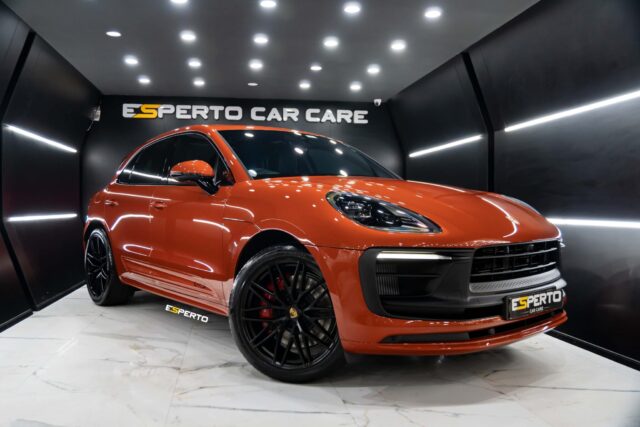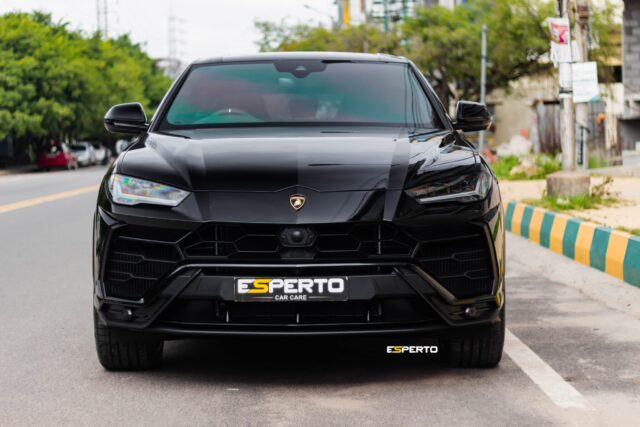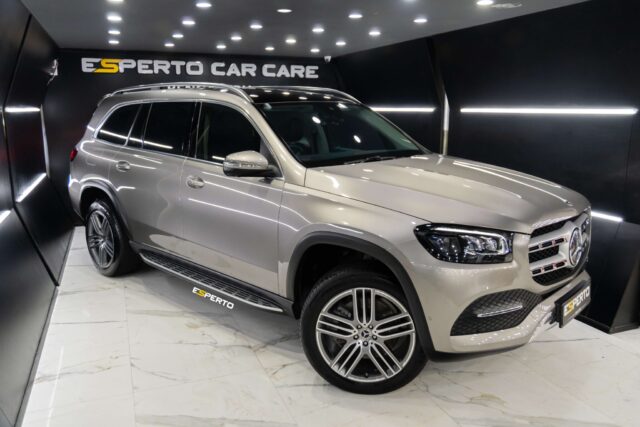Protecting your car from UV rays and sun damage is essential for maintaining its appearance and longevity. Prolonged exposure to the sun can cause fading, oxidation, and deterioration of both the exterior paint and interior surfaces. Fortunately, several protective measures, such as UV-resistant car covers, ceramic coatings, and window tints, can help shield your vehicle from harmful radiation. Regular maintenance, including washing and waxing, also plays a crucial role in preserving the car’s finish. In this guide, we’ll explore effective strategies to safeguard your vehicle against UV exposure and extend its lifespan.
How to Protect Your Car Paint from UV Damage?
Protecting a car’s paint from UV damage involves using specific products to shield and preserve the car wash and finish.
Methods for applying UV protective coatings effectively guarantee that the vehicle’s exterior remains resilient against sun exposure.
Additionally, regular maintenance can greatly enhance these protective measures, contributing to the longevity of the car and its aesthetic appeal.
What are the Best Products for Car Paint Protection
Why should you consider investing in quality products to safeguard your car’s paint from UV damage? UV rays can significantly degrade your car’s exterior, diminishing its value and aesthetics. Products like car covers, paint protection films, and ceramic coatings act as a protective layer, shielding your car’s tires from harmful sun exposure. Regularly waxing your vehicle enhances its shine and adds another layer of UV protection.
| Product Type | Benefits | Recommended Use |
|---|---|---|
| Car Cover | Shields from direct UV exposure | Daily when parked |
| Car Wax | Provides glossy, protective layer | Wax your car regularly |
| Ceramic Coating | Long-lasting UV protection | Apply every few years |
| Tinted Windows | Reduces interior UV penetration | Install professionally |
Utilizing these products guarantees long-term preservation of your car’s paint, maintaining its vibrancy and integrity and comprehensive protection against UV damage.
How to Apply UV Protection to Your Car’s Paint
Applying UV protection to preserve the car’s paint is crucial for maintaining its look and resale value. Regular car maintenance should include measures to shield the vehicle’s paint from the harsh effects of UV rays.
Prolonged exposure to UV rays can degrade the clear coat that protects the paint job, leading to fading and other damage. Utilizing a high-quality car cover can provide an additional layer of defense when the vehicle is parked outdoors.
Additionally, waxing the car regularly not only enhances its shine but also adds a protective barrier against UV rays. Implementing UV protection for car paint, such as specific protective coatings, guarantees the car’s aesthetic appeal and structural integrity are preserved over time.
What are the Benefits of Regular Car Maintenance
Regular car maintenance, including protection against UV damage, dramatically extends the lifespan and enhances the appearance of vehicle paint.
Regular washing maintains this appearance and stops the accumulation of damaging substances that can deteriorate the paint quality over time.
Monitoring the car’s fluids, such as engine oil and power steering fluid, and ensuring they are at ideal levels supports the vehicle’s smooth operation.
Checking tire and air pressure and the air conditioning system regularly contributes to vehicle efficiency and comfort.
Long-term maintenance reduces the likelihood of costly repairs, as potential issues are addressed promptly.
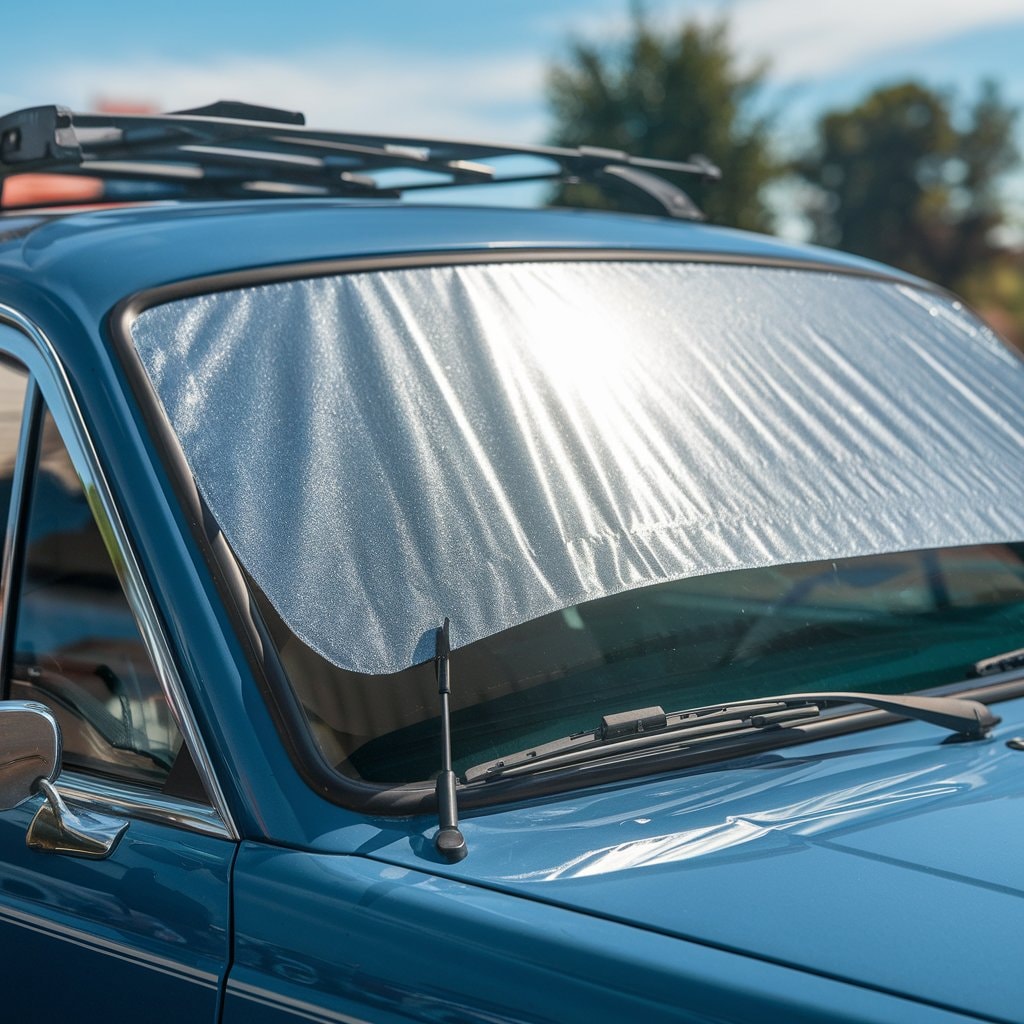
How Does UV Exposure Affect Your Car?
UV exposure can considerably deteriorate a car’s paint, leading to fading, oxidation, and peeling.
Inside the vehicle, the sun’s rays can cause similar degradation to the dashboard, leather seats,, and other interior components, making UV protection vital.
Understanding these impacts highlights why safeguarding a vehicle from UV damage is crucial for preserving its condition, aesthetics, and functional integrity.
What are the Effects of the Sun on Car Paint
While often overlooked, the impact of UV rays on car paint can be severe, leading to noticeable deterioration over time. Prolonged exposure to UV from the sun’s rays can break down your car’s paint, causing it to fade, peel, or crack.
This damage is not just cosmetic but can also affect the vehicle’s value and integrity. When exposed to direct sunlight regularly, the exterior paint undergoes a breakdown of its chemical bonds, resulting in the dulling of vibrant colors and the weakening of the surface.
To protect car paint from sun damage, it is essential to mitigate these damaging effects using protective coatings or covers that shield the paint from direct UV rays. This preventive measure helps maintain the car’s aesthetic appeal and structural resilience.
How Does Sun Damage Your Car’s Interior
Just as UV rays can damage a car’s exterior paint, they also have a deleterious effect on the vehicle’s interior. Prolonged sun exposure leads to the fading of interior surfaces, including leather and fabric seats.
UV rays accelerate the degradation of these materials, causing them to crack, fade, and weaken over time. This type of upholstery damage detracts from the aesthetic appeal of the car’s interior and can significantly reduce its resale value.
To protect your car’s interior, it is crucial to reduce its exposure to direct sunlight and consider using protective coatings or covers. Such measures help preserve the integrity and appearance of interior components, ensuring they remain in prime condition despite the challenging effects of UV rays.

Why is UV Protection Important for Your Vehicle
Protecting a vehicle from ultraviolet (UV) radiation is vital due to the extensive damage these rays can inflict on the exterior and interior of the car.
Prolonged exposure to UV radiation can cause significant UV damage to a car’s exterior, including the fading and deterioration of car paint from UV rays. Sun protection measures are essential to protect your car’s appearance and structural integrity.
The sun’s UV rays can also degrade interior materials such as dashboards and upholstery, necessitating sun protectants.
What are the Best Ways to Protect Your Car from the Sun?
Understanding the frequency of using a car cover is essential to shield a vehicle from harmful UV rays.
Paint protection film plays a critical role by creating a barrier that defends the paint from sun damage and oxidation.
Additionally, strategies to maintain a more extraordinary interior can significantly improve the vehicle’s longevity and comfort.
How Often Should You Use a Car Cover
Utilizing a car cover regularly is essential for safeguarding your car’s paint and interior from UV rays, sun damage, and high temperatures caused by direct sun and extreme sunlight.
Here are the best practices:
- Daily Use: Cover your vehicle daily if parked outdoors to protect it from UV rays and maintain interior coolness.
- Reflective Material: Choose covers with reflective properties to deflect harsh sunlight.
- Proper Fit: Verify the cover fits snugly to prevent exposure to elements and potential damage.
- Breathability: Opt for a breathable fabric to avoid moisture buildup and reduce the risk of corrosion and mold inside the vehicle.
What is the Role of Paint Protection Film
While car covers offer a practical solution for shielding your vehicle from daily sun exposure, paint protection film provides a more permanent defense against UV rays.
This film is expertly designed to safeguard a car’s surface and exterior paint from the harmful UV rays that cause sun damage. By forming a robust barrier on the car exterior, paint protection film mitigates the effects of sun exposure and preserves the vehicle’s aesthetic appeal.
It helps protect your car’s exterior from UV radiation and guarantees thorough protection against minor abrasions and stains.
Utilizing paint protection film is an effective way to maintain the car’s appearance and prevent the degradation of the new car’s paint quality over time.
How Can You Keep Your Car Cool
Ensuring your car stays cool and shielded from intense sun requires a multipronged approach. Effective strategies enhance comfort, preserve the vehicle’s interior, and contribute to its Longevity.
Here are some of the best ways to achieve this:
- Use a car cover: This shields your vehicle from direct sunlight, markedly reducing the temperature inside your car.
- Opt for window tinting: Professionally applied tints can block a substantial amount of UV radiation, helping to keep your vehicle cool.
- Seek shaded parking: Park your car in the shade whenever possible to minimize exposure to summer heat.
- Maintain the air conditioning system: Regular checks and servicing guarantee it operates efficiently, relieving the heat when driving.
What Steps Can You Take to Shield Your Car’s Interior?
To safeguard a car’s interior, attention must first be paid to the upholstery, which is highly susceptible to damage from UV rays.
Utilizing window tints can enhance UV protection, blocking harmful rays from deteriorating the interior fabrics and materials.
These measures are essential in maintaining the condition and appearance of rubber parts of the car’s interior over time.
How Can You Protect Your Car’s Upholstery
Protecting your car’s upholstery is vital for maintaining a quality car’s aesthetic and functional value.
UV radiation can cause significant damage to car interiors, particularly leather car seats, which can crack and fade over time. Here are effective measures to protect the surfaces inside your car:
- Use Seat Covers: Durable seat covers shield leather car seats from sun damage.
- Apply UV Protectant: Regularly use products that protect and moisturize the interior.
- Park in Shade: Whenever possible, choose shaded parking to minimize direct sunlight exposure.
- Regular Cleaning: Consistent car cleaning helps maintain upholstery and prevents dust particles from magnifying UV damage.
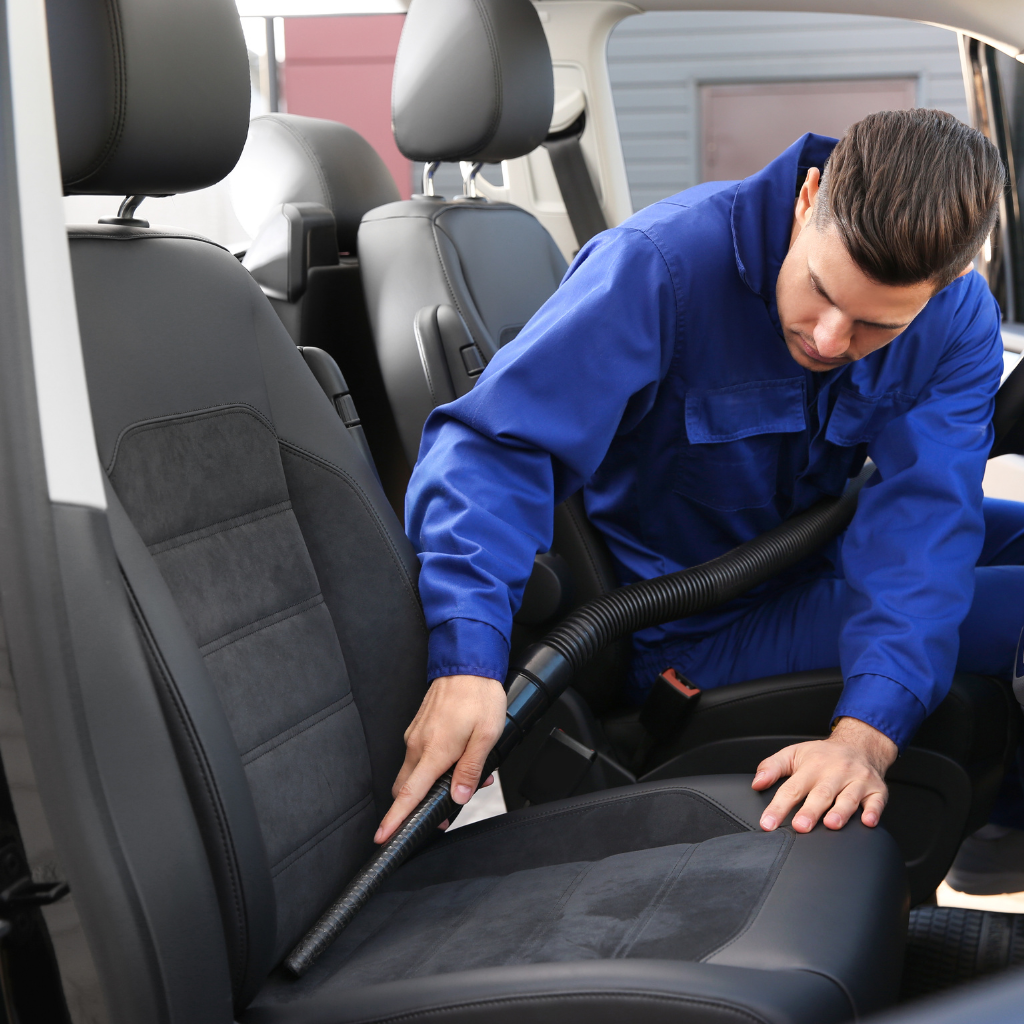
What Role Do Window Tints Play in UV Protection
While protecting a car’s upholstery is essential, another effective method in safeguarding the car window interior from UV rays involves using Car window film.
These tints can significantly reduce exposure to UV light, preventing sun damage that can harm your car’s dashboard, seats, and other surfaces. By blocking harmful UV rays, window tints act as a sun shield, mitigating the risk that the sun can cause to the aesthetics and functionality of your vehicle’s interior.
Additionally, pairing window tints with a car cover can protect the vehicle further when parked outdoors. This dual approach guarantees thorough protection, helping to maintain the integrity and appearance of your car, safeguarding it against the pervasive threat of sun-induced deterioration.
Why is Regular Car Maintenance Essential for UV Protection?
Regular car maintenance is essential for protecting vehicles against harmful UV rays.
This section explores how frequent washing can shield the car’s finish, the advantages of utilizing car covers, and methods for inspecting sun damage.
Each aspect is vital in prolonging the lifespan and preserving the car’s aesthetic appeal.
How Does Washing Your Car Regularly Help
Maintaining a clean car through regular washing greatly enhances battery life and its protection against harmful UV rays.
Regularly removing dirt, other debris, and other contaminants prevents them from bonding with the car’s paint, which can lead to oxidation under the sun’s intense exposure. This care is essential as these elements can break down your car’s paint over time, leading to significant damage.
- Prevents Build-up: Regular washing keeps damaging agents like dirt and salt from accumulating.
- Protects Paint: Washing helps maintain the integrity of the car’s paint, shielding it from UV degradation.
- Reduces Damage: Removing particles quickly minimizes the risk of scratches that can worsen under UV exposure.
- Enhances Longevity: Consistent cleanliness extends the overall lifespan of the car’s exterior finishes.
What are the Benefits of Using a Car Cover
In addition to regular washing, a car cover is another effective strategy for protecting a vehicle from the damaging effects of UV rays. A car cover is a physical barrier between the scorching sun and your vehicle, shielding the car’s paint from the sun’s heat and preventing sun damage. By blocking UV rays, a car cover helps protect your car’s exterior and interior from fading and cracking due to extreme heat. This not only maintains the aesthetic appeal of your vehicle but also enhances its Longevity.
How to Inspect Your Car for Sun Damage
Car owners should periodically inspect their vehicles for signs of sun damage to effectively guard against the deterioration caused by UV rays.
Regular maintenance is essential to protect your car’s exterior paint, which can be severely affected by exposure to UV rays. Intense sunlight, especially during the hot weather of the summer sun, can break down your car’s paint, leading to fading and cracking.
- Check for fading: Examine the car’s paint for any uneven shades or lighter colors that indicate damage.
- Look for cracking: Notice small cracks or splits, particularly on the hood and roof.
- Inspect for peeling: Verify the clear coat isn’t peeling off, which exposes the underlying paint.
- Evaluate the headlights: Look for haziness or yellowing of the plastic from UV exposure.
Conclusion
In summary, safeguarding a vehicle from UV rays and sun damage is essential for preserving its aesthetic and functional integrity. Owners can significantly extend the lifespan and appearance of their vehicles by implementing protective measures such as using quality car covers, parking in shaded areas, applying UV-resistant wax, and maintaining the car’s interior. Regular maintenance also plays a pivotal role in ensuring that the vehicle remains resilient against the detrimental effects of sun exposure.


